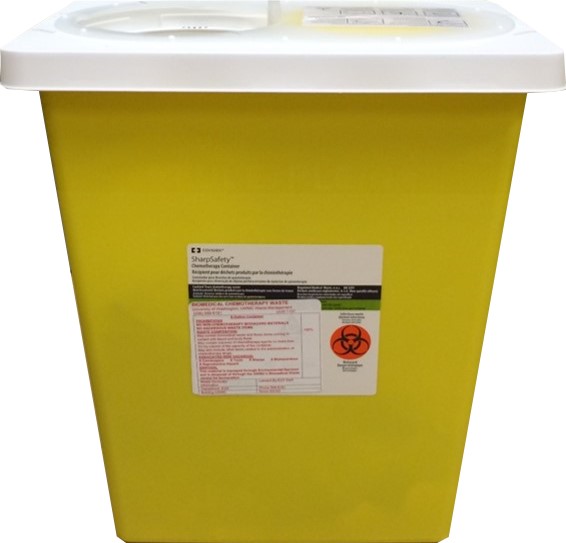Chemotherapy & Hazardous Drugs
Drugs are classified as hazardous if they may cause cancer, developmental or reproductive toxicity or harm to organs at low doses. They include drugs used for cancer chemotherapy (also called antineoplastics), antiviral drugs, hormones, some bioengineered drugs and other various drugs.
Check the NIOSH List of Antineoplastic and Other Hazardous Drugs in Healthcare Settings (2014) to determine if a drug is classified as hazardous.
Safe use and handling
Follow safety precautions when working with hazardous drugs. These include use of exhausted enclosures, procedures to avoid personal exposure and contaminating surfaces, personal protective equipment (PPE) and training of personnel in hazard awareness and safe work practices.
Federal and state regulations and guidelines exist for the use, handling, storage, treatment and disposal of hazardous drugs in clinical and research settings. Environmental Health & Safety (EH&S) has developed guidance that includes procedures for safety, compliance and best practices. For research involving hazardous drugs at UW, follow these guidelines:
For veterinary clinical care, use the Veterinary Hazardous Drug Program Guide from Washington State Labor & Industries.
Waste: Trace vs Non-Trace
Manage chemotherapy (chemo) and hazardous drug waste separately from other waste streams such as biohazardous waste. Chemo/hazardous drug waste should not be autoclaved. Collect chemo/hazardous drug waste as either trace or non-trace waste as defined below.
Trace Waste
"Trace" refers to empty containers or containers that have less than 3% of the original quantity of drug remaining, such as sharps, empty syringes and vials. An "empty" container is one in which all contents have been removed by normal means such as aspiration, pouring or flushing.
Non-Trace Waste and P-Listed Drugs
Non-trace chemo/hazardous drug waste refers to unused or expired drugs, containers with more than trace amounts of chemo/hazardous drug, contaminated PPE and contaminated items from preparation, use, and clean-up. Dispose of non-contaminated PPE and other items in the trash.
Environmental Protection Agency (EPA) P-listed drugs are acutely hazardous drugs regulated by federal law. Handle all P-listed drug waste (including empty containers and trace amounts) as non-trace chemo/hazardous drug waste. P-listed chemo/hazardous drugs include:
| Waste Code |
Constituent of Concern |
Product Name Examples |
| P001 |
Warfarin and salts (>0.3%) |
Coumadin, Warfarin |
| P012 |
Arsenic trioxide |
Trisenox |
| P042 |
Epinephrine |
Adrenaline, EpiPen, Eppy/N, Epifrin, Epinal, Anaphylaxis kit, Epinephrine, Racepinephrine, Racord, Primatene inhaler |
| P046 |
Phentermine |
Phentermine (CIV) |
| P075 |
Nicotine and salts |
Nicotine patches, Habitrol, Nicoderm, Nicorette, Nicotrol, Tetrahydronicotyrine |
| P188 |
Physostigmine salicylate |
Eserine salicylate |
| P204 |
Physostigmine |
Eserine |
Source: WA State Dept. of Ecology RCRA list
Trace Chemo/Hazardous Drug Waste
Collect in yellow sharps waste container:
- sharps with trace chemo/hazardous drugs
- sharps with trace chemo/hazardous drugs and biohazards
- empty chemo/hazardous drug vials and containers (<3% of original quantity)

Label as "trace chemo waste" with PI name and room number. Containers are available for purchase from Biochemistry stores or from lab/medical supply vendors. Refer to the Sharps and Laboratory Glass webpage for sharps definitions. Use the Sharps Waste poster for help.
All trace chemo and hazardous drug waste generated at the University of Washington is collected and shipped off site for disposal by incineration at a regulated facility.
-
EH&S training is required for any personnel who will package and ship waste.
-
Contact Laboratory Services in Health Sciences Academic Services and Facilities to set up an account with a UW waste contractor.
Non-Trace Chemo/Hazardous Drug Waste
Collect for hazardous chemical waste pickup by EH&S:
- unused or expired chemo/hazardous drugs
- containers with more than trace amounts of chemo/hazardous drugs
- P-listed drugs and empty containers
- sharps with P-listed drugs
- visibly contaminated items from preparation, use and clean-up (PPE, pads, etc.)
All non-trace chemo/hazardous drug and P-listed drug waste generated at the University of Washington is collected as hazardous chemical waste by EH&S and shipped off site for disposal by incineration at a regulated RCRA facility.
Visit the Chemical Waste page to request a collection of non-trace waste.
What you can do to stay safe
- Follow the guidelines for safe use and handling.
- Learn to identify trace vs non-trace waste.
- Do not autoclave chemotherapy or hazardous drug waste.
- Take the required and recommended safety training courses.
Frequently asked question
No, trace chemo waste only includes empty containers, such as syringes or vials. Trace chemo waste does not include liquid waste. Refer to the definition of trace waste above.
Any liquid waste containing chemotherapy or hazardous drugs must be collected as hazardous chemical waste for pickup by EH&S. Visit the Chemical Waste page for more information.
